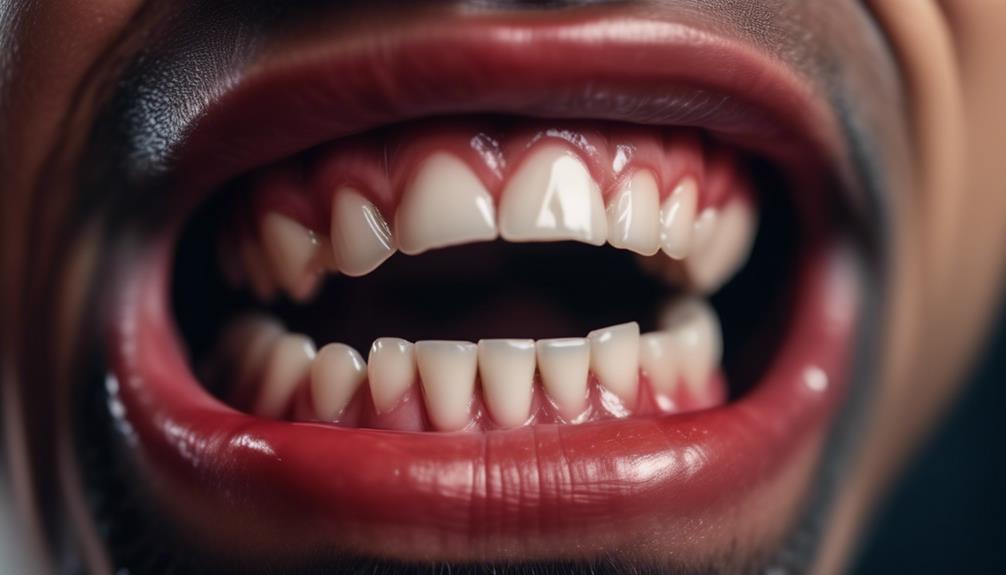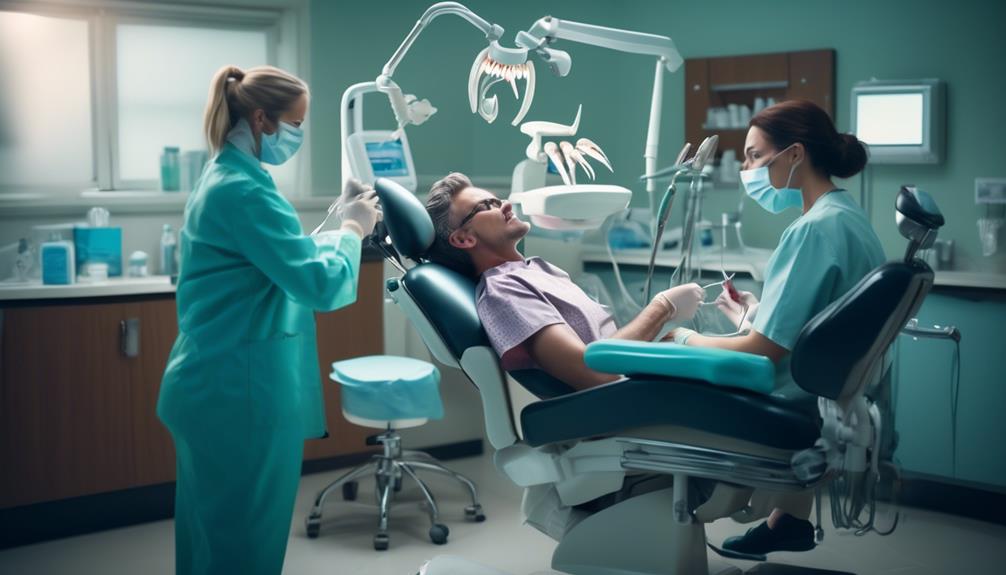Gum recession is a common dental issue that, if left untreated, can lead to significant oral health problems. While gum grafting is a proven technique to restore receding gums and prevent further damage, there remains a question of when it is too late to undergo this procedure. In this discussion, we will explore the signs of advanced gum recession, factors that can impact the success of gum grafting, and the ideal timing for this treatment. Furthermore, we will also explore alternative solutions for late-stage gum recession and the importance of seeking professional advice for individuals facing severe gum issues. As we delve into this topic, it is crucial to understand the implications of timing when it comes to gum grafting and how it can impact the overall effectiveness of the procedure.
Key Takeaways
- Early intervention is recommended for gum recession.
- Stability of the underlying condition should be ensured before undergoing gum grafting.
- Practicing good oral hygiene and regular dental check-ups can help prevent gum recession.
- Seeking professional advice and guidance is crucial for accurate diagnosis and effective treatment of gum issues.
Signs of Advanced Gum Recession

Advanced gum recession can be identified through several noticeable signs and symptoms. Gum recession refers to the process where the gum tissue surrounding the teeth wears away, exposing the tooth roots. While mild gum recession is a common dental issue, advanced gum recession requires immediate attention and treatment to prevent further oral health complications.
One of the most prominent signs of advanced gum recession is the appearance of longer teeth. As the gum tissue recedes, more of the tooth structure is exposed, making the teeth look longer than usual. Additionally, exposed tooth roots may become sensitive to hot or cold temperatures, causing discomfort or pain while eating or drinking.
Another symptom of advanced gum recession is the development of deep pockets between the teeth and gums. These pockets provide a breeding ground for harmful bacteria, leading to gum infections and eventual tooth loss if left untreated. Along with deep pockets, individuals with advanced gum recession may experience gum inflammation, redness, and tenderness.
Tooth mobility is also a common indicator of advanced gum recession. As the gum tissue recedes, the supporting structures that hold the teeth in place become weaker, resulting in tooth movement or shifting. This can affect the bite and overall oral functionality.
If any of these signs or symptoms are present, it is crucial to seek gum recession treatment promptly. Gum grafting is a common procedure used to treat advanced gum recession. During this procedure, gum tissue is taken from another part of the mouth and placed over the exposed tooth roots, restoring the gum line and preventing further recession.
Factors That Affect Gum Grafting Success
Several factors can influence the success of gum grafting, a common procedure used to treat advanced gum recession. The success of gum grafting relies heavily on the techniques used during the procedure and the long-term prognosis for the patient.
One important factor is the choice of gum grafting technique. There are several techniques available, including connective tissue grafts, free gingival grafts, and pedicle grafts. Each technique has its own advantages and disadvantages, and the choice depends on the specific needs of the patient. Connective tissue grafts, for example, involve taking tissue from the palate and placing it over the exposed root surface. This technique has been shown to provide excellent long-term results and is often the preferred choice for treating advanced gum recession. On the other hand, free gingival grafts involve taking tissue directly from the palate and placing it over the exposed root surface. While this technique can be effective, it may result in more discomfort for the patient and a longer healing time.
Another factor that can affect the success of gum grafting is the long-term prognosis for the patient. This includes factors such as oral hygiene, smoking habits, and overall health. Good oral hygiene is crucial for maintaining the health of the gums and preventing further recession. Smoking, on the other hand, can impair the healing process and increase the risk of complications. Patients with underlying health conditions, such as diabetes, may also have a higher risk of complications and a lower success rate for gum grafting.
Ideal Timing for Gum Grafting

Determining the optimal timing for gum grafting is a critical consideration in achieving successful outcomes for patients with gum recession. The ideal timing for gum grafting depends on several factors, including the extent of gum recession, the underlying cause, and the overall oral health of the patient. Here are four key points to consider when determining the ideal timing for gum grafting:
- Early intervention: It is generally recommended to address gum recession and consider gum grafting as soon as it is detected. Early intervention can help prevent further progression of gum recession and minimize the risk of long-term complications.
- Stability of the underlying condition: Before undergoing gum grafting, it is essential to ensure that the underlying cause of gum recession, such as gum disease or improper oral hygiene, is under control. Treating and stabilizing the underlying condition will enhance the success of the gum grafting procedure.
- Overall oral health: The patient’s overall oral health plays a crucial role in determining the ideal timing for gum grafting. Good oral hygiene practices, regular dental visits, and a healthy lifestyle can contribute to the long-term success of gum grafting.
- Patient’s preference: The patient’s preference and willingness to undergo gum grafting should also be taken into consideration. Open communication between the patient and the dental professional will help determine the most suitable timing for the procedure.
Considering the ideal timing for gum grafting is crucial for achieving optimal long-term effects. Early intervention, stabilization of the underlying condition, overall oral health, and the patient’s preference are all important factors to consider when determining the right timing for gum grafting. By addressing gum recession promptly and with careful consideration, patients can expect successful outcomes and improved oral health in the long run.
Alternative Solutions for Late-stage Gum Recession
In cases of late-stage gum recession, when gum grafting may not be feasible, there are alternative solutions available to address the condition. While gum grafting is considered the gold standard treatment for gum recession, there are non-surgical options that can help prevent further recession and improve the overall health of the gums.
One alternative solution is the use of dental splints or braces. These devices help to stabilize the teeth and prevent further movement, which can contribute to gum recession. By keeping the teeth in their proper position, the gums are given the opportunity to heal and potentially grow back to a healthier state.
Another non-surgical option is the use of minimally invasive procedures such as scaling and root planing. This involves removing plaque and tartar from the teeth and smoothing the root surfaces to promote gum reattachment. These treatments can help reduce gum inflammation and prevent further recession.
In addition to these procedures, practicing good oral hygiene at home is crucial for gum recession prevention. This includes brushing twice a day with a soft-bristled toothbrush, using a fluoride toothpaste, and flossing daily. Regular dental check-ups and professional cleanings are also essential in maintaining gum health.
While these alternative solutions can be effective in managing late-stage gum recession, it is important to note that they may not completely reverse the condition. In some cases, gum grafting may still be necessary to restore the gums to their original position. Therefore, it is important to consult with a dental professional to determine the most appropriate treatment plan for your specific situation.
Seeking Professional Advice for Late-stage Gum Issues

When faced with late-stage gum issues, it is imperative to seek professional advice from a qualified dental professional. These experts can provide a thorough assessment of your gum health and recommend the most appropriate treatment options. Here are four reasons why seeking a professional consultation for late-stage gum issues is crucial:
- Accurate Diagnosis: A dental professional can accurately diagnose the extent of your gum recession and determine the underlying causes. This is essential in developing an effective treatment plan tailored to your specific needs.
- Expert Guidance: A professional consultation allows you to receive expert guidance on the available treatment options for gum recession. They can explain the pros and cons of each option, helping you make an informed decision based on your oral health goals.
- Customized Treatment Plan: Each case of gum recession is unique, and a professional consultation ensures that your treatment plan is customized to address your specific concerns. This personalized approach enhances the chances of successful gum recession treatment.
- Monitoring and Follow-up: After undergoing gum recession treatment, regular monitoring and follow-up are essential to ensure the long-term success of the procedure. Dental professionals can provide the necessary guidance and support throughout your recovery journey.
To effectively address late-stage gum issues, seeking professional advice is crucial. A dental professional can provide an accurate diagnosis, expert guidance, a customized treatment plan, and ongoing monitoring and follow-up. Don’t hesitate to schedule a professional consultation to start your journey towards healthier gums.
Frequently Asked Questions
Can Gum Grafting Be Done if I Have Advanced Gum Recession?
Gum grafting surgery can be performed even in cases of advanced gum recession. This procedure involves taking tissue from the palate or a donor source and grafting it onto the affected area to restore gum tissue and improve oral health.
What Are the Risks and Complications Associated With Gum Grafting Surgery?
Risks and complications associated with gum grafting surgery include infection, bleeding, and graft failure. Alternatives to gum grafting include dental implants and dentures. Recovery time can vary, but it typically takes a few weeks.
Is Gum Grafting a Permanent Solution for Late-Stage Gum Recession?
Gum grafting can provide permanent results in late-stage gum recession, with a high success rate. This procedure involves taking tissue from one area and placing it in the receding area, promoting tissue regeneration and improving oral health.
How Long Does It Take to Recover After Gum Grafting Surgery?
The recovery time after gum grafting surgery varies depending on the individual, but typically takes about 1-2 weeks. Post operative care, such as maintaining good oral hygiene and avoiding hard foods, is crucial for successful healing.
Are There Any Non-Surgical Alternatives to Gum Grafting for Late-Stage Gum Recession?
Non-surgical gum recession treatments offer alternative methods for treating late-stage gum recession. These treatments provide viable options for patients who may not be suitable candidates for gum grafting surgery or prefer a less invasive approach.
Conclusion
In conclusion, determining the appropriate timing for gum grafting is crucial for successful treatment of advanced gum recession. Factors such as the extent of recession, oral hygiene habits, and overall health play a significant role in the success of the procedure. Seeking professional advice is essential to explore alternative solutions and receive appropriate treatment for late-stage gum recession. Just as a compass guides a lost traveler, professional guidance can navigate patients towards optimal oral health.

